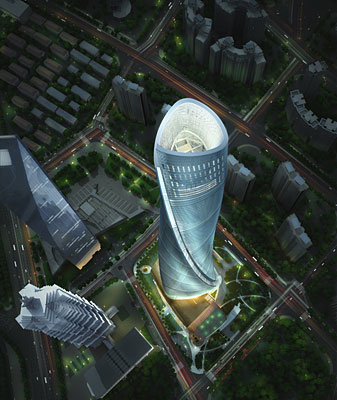Despite Sinking Economy, Work Begins on Super-Tall Shanghai Tower

Shanghai Tower

Shanghai Tower

Shanghai Tower

Shanghai Tower

Shanghai Tower

Shanghai Tower

Shanghai Tower

Shanghai Tower








Defying signs that the global economy is in a major downturn, the 2,074-foot-tall Shanghai Tower, designed by Gensler, broke ground on Friday, November 28. The mixed-use glass-and-steel tower is slated to be the tallest building in China.
While construction of other skyscrapers, such as Norman Foster’s Moscow Tower and Santiago Calatrava’s Chicago Spire, has been halted due to the market downturn, the Shanghai Tower project is moving full speed ahead, according to the architects. “The client understands that there are cycles in the market,” says Jun Xia, a principal in Gensler’s Shanghai office. “The client is confident in positioning this building as the first significant building in the new cycle when it is completed in 2014.”
The client, the Shanghai Tower Construction and Development Corporation, comprises three state-owned entities: a construction company, a commercial development company, and a development company that is heavily invested in urban infrastructure. Xia says that unlike speculative projects, “the funding is already there” for Shanghai Tower.
After a lengthy competition process that began in 2006, Gensler was named the project’s architect in June 2008, beating out a field of heavyweight favorites like Kohn Pedersen Fox (KPF), Skidmore Owings and Merrill (SOM), and Foster + Partners.
Located in the Lujiazui section of Pudong, the Shanghai Tower will sit adjacent to the 1,214-foot-tall Jinmao Tower (1998), designed by Adrian Smith during his tenure at SOM, and the just-completed 1,614-foot-tall Shanghai World Financial Center, by William Pedersen of KPF. Shanghai Tower—which will house offices, stores, and a hotel—is the last major part of a master plan for Pudong. The plan, conceived in the 1990s, envisioned three super-tall buildings, each taller than the next, rising next to each other.
The 128-story Shanghai Tower will be a double-skinned building that torques and tapers as it rises. Its upper floors reportedly will contain the world’s highest unenclosed observation deck.
The project calls for several green features. Reminiscent of David Childs’ design for the Freedom Tower in New York, the Shanghai Center will be topped by a series of windmills that will generate energy for the building. The tower also will have rainwater collection facilities. Moreover, to minimize the amount of trips occupants have to make to the ground level, basic services and common spaces will be located on every dozen or so floors. Mechanical systems also will be located on these floors.
Gensler is working with the structural engineering firm Thornton Tomasetti and the M/E/P firm Cosentini Associates. The Architectural Design and Research Institute of Tongji University, in Shanghai, also is contributing to the project.








